Thomas Wharton's Blog, page 19
January 13, 2012
Story-suckers
Blood-hobs (also known as story-suckers) are some of the truly shudder-worthy creatures in the Realm. Blood-hobs are difficult to see, since they only come out at night, but even more than that, they're not fully solid, material beings. Enigmatists say that only the circulatory and lymph systems of a blood-hob exist in the realm of matter, while most of the rest of them lives in the spirit world, and so their contact with creatures of flesh and bone like us is tenuous. You may think you see a blood-hob in front of you, but if you try to grasp it, you're usually left with a sensation that your hand has passed through some damp miasma that's left your skin unpleasantly cold and wet.
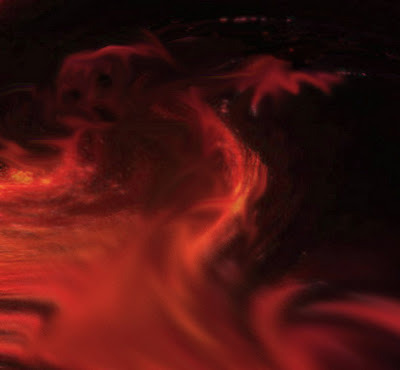 Blood-hobs are drawn to storystuff. What loremasters call innumith, or the fathomless fire. It's the spark that starts deep in the mind and grows into a story. That's why sometimes, late at night, if you're listening to someone tell a story, or telling one yourself, you may have the sense that someone or something else is listening, too, over your shoulder. What these creatures want from our stories is not clear.
Blood-hobs are drawn to storystuff. What loremasters call innumith, or the fathomless fire. It's the spark that starts deep in the mind and grows into a story. That's why sometimes, late at night, if you're listening to someone tell a story, or telling one yourself, you may have the sense that someone or something else is listening, too, over your shoulder. What these creatures want from our stories is not clear.Sometimes the fathomless fire burns out of control and becomes werefire, the flame of hallucination and obsession. Blood-hobs feast on this stuff. And sometimes they attach themselves to people who spend too much time around the werefire. They invade such a person's mind, and feed off their fevered dreams and fantasies.

Published on January 13, 2012 09:01
January 8, 2012
The Fathomless Fire heats up
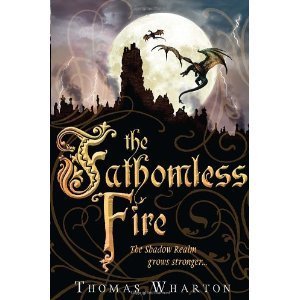
The Fathomless Fire, the second book of the Perilous Realm trilogy, is now – or will soon be – on bookstore shelves!
When a strange messenger from the Perilous Realm foretells danger, Will Lightfoot realizes his friends, Rowen and her grandfather, the loremaster Nicholas Pendrake, need him in the land of Story—a world where nothing is as it seems. And so Will returns to the Realm and begins a dangerous search for his former companion, the wolf, Shade. Meanwhile, despite the overshadowing threat of the Night King, Rowen ventures into the Weaving, the mysterious source of all stories, to find her grandfather and discover what it really means to be a loremaster…
The Shadow of Malabron was very much Will's book, as it concerned his journey to return home from this strange and terrifying world he'd stumbled into. In The Fathomless Fire, Rowen begins a difficult quest of her own, and takes a central role in the story. Some of the other characters from the first book return as well, as the threat of the Night King grows, and the threads of his own dark, ruinous story weave more tightly around the city of Fable.
The Fathomless Fire will be launched at Greenwood's Books in Edmonton on February 1st at 7 PM.

Published on January 08, 2012 11:40
December 31, 2011
The Little Match Girl - A New Year's Eve tale
I've always wondered why Hans Christian Andersen set this story on New Year's Eve. Probably as a stark reminder, which is just as timely today, that while we look forward to better things and happier moments with the arrival of a new year, the world's injustice and misery won't vanish just because the date changes.
The Little Match Girl
It was so terribly cold. Snow was falling, and it was almost dark. Evening came on, the last evening of the year. In the cold and gloom a poor little girl, bareheaded and barefoot, was walking through the streets. Of course when she had left her house she'd had slippers on, but what good had they been? They were very big slippers, way too big for her, for they belonged to her mother. The little girl had lost them running across the road, where two carriages had rattled by terribly fast. One slipper she'd not been able to find again, and a boy had run off with the other, saying he could use it very well as a cradle some day when he had children of his own. And so the little girl walked on her naked feet, which were quite red and blue with the cold. In an old apron she carried several packages of matches, and she held a box of them in her hand. No one had bought any from her all day long, and no one had given her a cent.
Shivering with cold and hunger, she crept along, a picture of misery, poor little girl! The snowflakes fell on her long fair hair, which hung in pretty curls over her neck. In all the windows lights were shining, and there was a wonderful smell of roast goose, for it was New Year's eve. Yes, she thought of that!
In a corner formed by two houses, one of which projected farther out into the street than the other, she sat down and drew up her little feet under her. She was getting colder and colder, but did not dare to go home, for she had sold no matches, nor earned a single cent, and her father would surely beat her. Besides, it was cold at home, for they had nothing over them but a roof through which the wind whistled even though the biggest cracks had been stuffed with straw and rags.
Her hands were almost dead with cold. Oh, how much one little match might warm her! If she could only take one from the box and rub it against the wall and warm her hands. She drew one out. R-r-ratch! How it sputtered and burned! It made a warm, bright flame, like a little candle, as she held her hands over it; but it gave a strange light! It really seemed to the little girl as if she were sitting before a great iron stove with shining brass knobs and a brass cover. How wonderfully the fire burned! How comfortable it was! The youngster stretched out her feet to warm them too; then the little flame went out, the stove vanished, and she had only the remains of the burnt match in her hand.
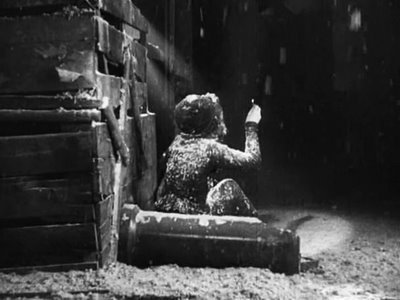
She struck another match against the wall. It burned brightly, and when the light fell upon the wall it became transparent like a thin veil, and she could see through it into a room. On the table a snow-white cloth was spread, and on it stood a shining dinner service. The roast goose steamed gloriously, stuffed with apples and prunes. And what was still better, the goose jumped down from the dish and waddled along the floor with a knife and fork in its breast, right over to the little girl. Then the match went out, and she could see only the thick, cold wall. She lighted another match. Then she was sitting under the most beautiful Christmas tree. It was much larger and much more beautiful than the one she had seen last Christmas through the glass door at the rich merchant's home. Thousands of candles burned on the green branches, and colored pictures like those in the printshops looked down at her. The little girl reached both her hands toward them. Then the match went out. But the Christmas lights mounted higher. She saw them now as bright stars in the sky. One of them fell down, forming a long line of fire.
"Now someone is dying," thought the little girl, for her old grandmother, the only person who had loved her, and who was now dead, had told her that when a star fell down a soul went up to God.
She rubbed another match against the wall. It became bright again, and in the glow the old grandmother stood clear and shining, kind and lovely.
"Grandmother!" cried the child. "Oh, take me with you! I know you will disappear when the match is burned out. You will vanish like the warm stove, the wonderful roast goose and the beautiful big Christmas tree!"
And she quickly struck the whole bundle of matches, for she wished to keep her grandmother with her. And the matches burned with such a glow that it became brighter than daylight. Grandmother had never been so grand and beautiful. She took the little girl in her arms, and both of them flew in brightness and joy above the earth, very, very high, and up there was neither cold, nor hunger, nor fear-they were with God.
But in the corner, leaning against the wall, sat the little girl with red cheeks and smiling mouth, frozen to death on the last evening of the old year. The New Year's sun rose upon a little pathetic figure. The child sat there, stiff and cold, holding the matches, of which one bundle was almost burned.
"She wanted to warm herself," the people said. No one imagined what beautiful things she had seen, and how happily she had gone with her old grandmother into the bright New Year.
-- Translation by Jean Hersholt
-- Image: from the 1928 film La Petite Marchande d'Alumettes by Jean Renoir

Published on December 31, 2011 10:11
December 22, 2011
Ice dragons part 2
Due to the popularity of my 2009 post on ice dragons, I thought it would be a good idea to provide some more information on these magnificent and terrifying creatures.
As related in the earlier post, the lands ruled by the ice dragons have dwindled considerably over the ages. And as the rivers of ice have receded with the warming of the world, so have the ice dragons become more rare, and in some cases, smaller and less powerful. Nevertheless, if you're going to travel in the regions where these creatures dwell, it's still important to be on your guard. Make sure you're carrying all the necessary equipment for survival, including rope, crampons for your shoes, a first aid kit, and warm, protective clothing. The dragons are still easily roused to anger when humans or others come clambering all over the glaciers they call home.
In one case I've heard of, a climber fell into a crevasse which turned out to be a dragon's mouth. The climber's companions struggled to get him out but he was stuck fast, and only escaped when the dragon relented at last and spat the man out through a crevasse lower down on the glacier. This unfortunate (or fortunate) traveler was renowned from then on for being the only known person to survive a trip through the digestive tract of a dragon.
Few people know that Santa's workshop at the North Pole is guarded by a semi-tame ice dragon called the Yulewyrm. This creature is the reason the workshop has not yet been found: the dragon's massive body distorts compass readings and his ability to cloak the area in a thick fog have been keeping explorers from finding the real North Pole.
One of the most well-known ice dragons is Whitewing Stonegrinder, whose ancestral home is the glacier surrounding the abandoned citadel of Aran Tir, as described in The Shadow of Malabron. Some enigmatists say that Whitewing Stonegrinder is the glacier, and that all this talk about dragons is nothing but a myth or just a colourful metaphor for the power and majesty of ice. If you've ever hiked or climbed a glacier, you'll have experienced the feeling that there is something alive under your feet, something powerful and fickle-tempered that has to be respected.
What is known for certain is that Whitewing Stonegrinder played an important role in the struggle against Malabron the Storyeater, as told in the three books of The Perilous Realm trilogy.

Supposed photograph of an ice dragon on Angel Glacier in the Canadian Rockies, c. 1917.

Published on December 22, 2011 11:35
December 15, 2011
Keep on questing
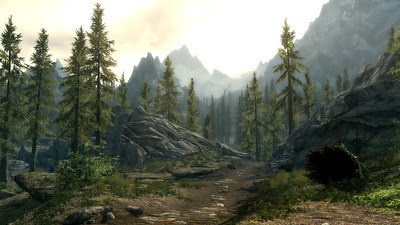
Someone stole your horse while you were down in the catacombs looking for the mystic amulet. That's annoying. You got the stupid amulet, but your expensive Elven-made armour is cracked now, and that old battle injury in your leg is acting up.
You start out on the winding mountain path for Starhaven Keep. Lord Thrandar wants that amulet, and he's promised you eight hundred gold pieces and a noble title. But suddenly you stop in the middle of the road. It's getting dark. There will be wolves out soon, hunting anything that dares walk this remote path. And worse things will come crawling out of the night, too. Beasts that a level seventeen warrior-mage such as yourself might not have the skill and experience yet to handle. It might be nice if you had a healing potion or two but you used those all up in the catacombs battling the Soulless Bureaucrats of Korthrakor.
But you're just standing here because you're wondering: why keep on? What's the point anymore? More gold? Fame? Noble titles? Experience points? Think of all those other adventurers out here right now, madly chasing after coins and amulets and greatness. Kill another monster and on we go to the next one. Fit in to someone else's preprogrammed scenario, where they make the rules that decide who and what you are allowed to be. It's so completely pre-scripted and pointless. The magic's gone out of the world and everyone's rushing toward the big conflagration like they can't wait for it to get here. The game ends with death. No more respawning. There's no glitch or cheat code that's gonna get you out of this one.
Keep on. Keep on even though your heart's not in it anymore. Keep on until you find a reason to keep on. And even if you don't find a reason, keep on if only to find out what it's like to be someone who keeps on through this meaningless game. There is no one else here like you. There never will be again. Keep on, with your eyes and ears and heart open. One day you may find you don't need reasons anymore, you don't need rewards, you're just here, and the real point of all this, the goal that nobody programmed into the game, is to help others keep on.
[Image: Screenshot from Skyrim]

Published on December 15, 2011 14:03
December 5, 2011
Story art
Some lovely and original interpretations of famous stories in art:

See some more of Christian Jackson's work at http://www.squareinchdesign.com/categ...
And here's another artist's interpretation of some famous stories:
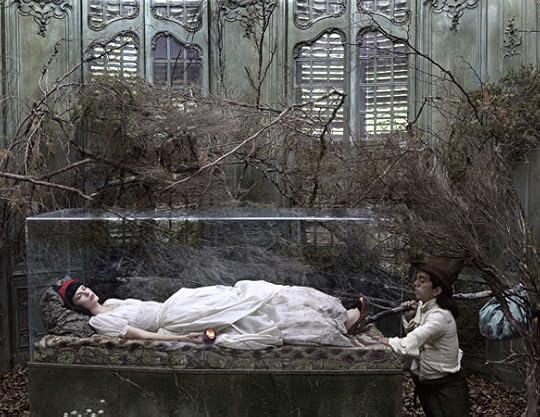
See more of Eugenio Recuenco's work at http://silentstoryteller.typepad.com/...
William Blake is one of my favourite artists, and I've often wondered what he would have come up with if he'd illustrated classic children's stories. Sometimes his illustrations to his own work suggest the possibility of stories other than those he intended. That's often the case for me with artwork: a brilliant, intense or disturbing image will seem to call out for a story to go along with it, and sometimes that's how I begin my stories, with nothing more than an image.
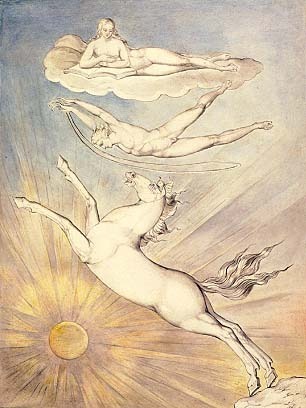
Surreal art in particular lends itself well with this kind of story-generating exercise, such as the work of Polish artist Rafał Olbiński, one of whose paintings was used as the cover art for the American edition of my novel Salamander.




See some more of Christian Jackson's work at http://www.squareinchdesign.com/categ...
And here's another artist's interpretation of some famous stories:

See more of Eugenio Recuenco's work at http://silentstoryteller.typepad.com/...
William Blake is one of my favourite artists, and I've often wondered what he would have come up with if he'd illustrated classic children's stories. Sometimes his illustrations to his own work suggest the possibility of stories other than those he intended. That's often the case for me with artwork: a brilliant, intense or disturbing image will seem to call out for a story to go along with it, and sometimes that's how I begin my stories, with nothing more than an image.

Surreal art in particular lends itself well with this kind of story-generating exercise, such as the work of Polish artist Rafał Olbiński, one of whose paintings was used as the cover art for the American edition of my novel Salamander.


Published on December 05, 2011 13:28
November 16, 2011
Writer's Block ... Party

In the realm of Story, where metaphors are real, writer's block isn't a condition, it's a place.
Writer's block is a huge concrete edifice, taking up one whole city block and rising many not-quite-finished stories into the dazzling sky of Silent City.
The enticing red light district known as Muse Mews is just down the street, but there's always construction going on between it and the Block, so it's actually pretty hard to get to.
Writers are always arriving at the Block and leaving at all times of the day and night. It's a bustling, happening place. Sort of a hotel slash spa slash prison slash drug store slash slash slash SLASH…. Sorry. Let me continue. Writers are arriving and leaving all the time. When you get there, you find to your surprise that there are many perks and conveniences. The lobby is well-lit. Very well-lit. And clean. And neat. And the rooms are actually quite comfortable and spacious. Most of them have well-stocked mini-bars and comfy beds and HD TV's and gaming consoles and big windows with great views where you can stand for hours, looking out over Silent City, thinking up all your awesome ideas for new stories.
And you discover to your relief that the Block is not the house of misery and gloom one might expect it to be. People who aren't writers are dropping by at all hours of the day and night because the Block has become known for its wild parties. Man, the stuff that happens at these parties. Good times. The strange thing is, though, the writers themselves are almost never to be found partying. They're more likely to be in the lobby, milling around in their pajamas (pyjamas?), looking for someone to tell about this great idea they have for a story about a writer who can't write.
Unlike the Hotel California, you can't check out any time you like, unfortunately. There's never anyone at the front desk. And suddenly you can't find the door. Where was the door? But you can leave. Yes, you can. Just not any time you like. Someone hands you a pencil and a pad of paper. You're told you have to make your own exit. You stand there, listening to the all-night all-day party booming away on some story far above you. You could go back there. Or maybe do something else. You haven't even checked out the pool or the hot tub, after all.
Or you could make your own exit. If only you knew how. You know how. You don't know how. The party is getting louder. It sounds like such fun. Actually it sounds desperate and sad. You don't know. Maybe there's a story about that. Maybe you should just go back to your room and look out the window for a while and maybe an idea will come to you.

Published on November 16, 2011 06:34
November 5, 2011
Taking care of our stories
"We must take care of our stories." -- Robert Kroetsch

I had to take care of a story once.
I found it by the side of the road one winter's evening when I was out for a walk. It was clear right away the story had been lost or abandoned, and my first thought was to just keep walking and let nature take its course, but I stopped. There was no ignoring what a sad state the story was in, and I didn't have my dark glasses on, so I couldn't pretend I hadn't seen it and walk on by.
So I took it home.
First I had to thaw the story out, and so I bundled it up in blankets in front of my stove. It took a little whiskey to warm things up. For me, that is, not the story. Still, I just couldn't sleep. I kept thinking, Why me? Nobody said, Here, this is yours now. It wasn't left to me in someone's will. I didn't sign any forms.
The next morning the story was still there in front of the stove, looking bleary-eyed and forlorn. I'd been hoping it would have gone while I was sleeping. But no. This had somehow become my responsibility.
We didn't get along too well as the days went by. The story didn't listen well. It was messy. It got in my way. As its strength came back it became it lost its wariness and became more demanding. I found myself spending less time with my own stories in order to deal with the needs of this stray, and they were many. And it didn't seem very grateful. I wondered often, What am I getting out of this?
But as I got to know the story better I began to understand it. I saw that it had a rich life, and that it had much to teach me, that the problem was as much my own unwillingness to listen as it was anything else. And so I listened. And the story got under my skin. And I no longer resented it. In fact I began to wonder how I had ever lived without it.
When I first encountered it I had thought the story was very old, but the longer it stayed with me the younger it seemed to be. It was always surprising me like that.
And then one day it was time for the story to go. It didn't bother with much of a farewell when it left, but that was all right. I knew it would be back. And this time it might be the story's turn to take care of me.

Published on November 05, 2011 09:14
October 28, 2011
The Whitemud Creek Troll: A Halloween Tale
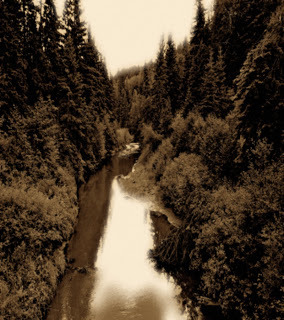
My name is Ben. I'm ten years old.
I live near Whitemud Creek. There's a ski hill down there and some hiking trails. The Whitemud Freeway crosses over the valley on a huge bridge. Every day thousands of cars zoom along the freeway and cross over the valley without giving a thought to what's down there.
My friends Sarah and Rahim and me rode our bikes down there the other day after school, just for something to do. We were riding under the freeway bridge when Sarah spotted something sort of half hidden behind one of the huge concrete piers that holds up the bridge. It looked like a big pile of junk: scrap metal and cardboard and all sorts of other stuff.
We stopped and went over to see what it was. And then the pile of junk moved. It looked up.
It wasn't a pile of junk, it was a troll. He had a big lumpy head like a boulder, and a really long nose, and pointy ears. What we had thought was a pile of junk was actually his clothes: it was like he had made himself a suit of armour out of the garbage that people sometimes dump in a place like this.
"Buzz off, humans," the troll said in a kind of raspy, gravelly voice.
"Hey, troll," I said, trying to sound cool about the whole thing, even though my heart had started pounding and I was ready to run for my life. But I wasn't going to do that unless Sarah and Rahim started running for their lives first, and since they hadn't, I couldn't either. It was kind of weird. We should have been screaming and running but we just stood there, as if it was perfectly normal to meet a troll under a bridge in Edmonton. For all we knew he might want to kill us and eat us.
"I'm not going to kill you and eat you," the troll said. We looked at one another. Sarah and Rahim must have been thinking the same thing I'd been thinking, and now I wondered if the troll could read minds.
"No, I can't read minds," the troll said, "but everybody who comes down here and sees me wonders if I'm going to eat them. It's what trolls are supposed to do, right?"
He looked at us as if the whole idea of eating people was stupid and gross, and I kind of relaxed a bit. I was becoming more curious than scared.
"Well, if you're not waiting here to jump out and eat people, then why are you down here at all?" Sarah asked.
"Because trolls live under bridges," the troll snapped at her. "It's what we do. Now go away."
"That's a cool suit of armour," Rahim said. "Did you make it yourself?"
"No, I went to that fancy men's clothing shop in Southgate Mall and had them make it for me," the troll said sarcastically. "What do you think? Of course I made it myself."
"Why do you need armour?" I asked.
"Because of the noise," the troll said.
"The noise?"
The troll pointed a long scaly finger over his head.
"All the noise of those blasted cars and trucks going over my head day and night. We trolls are very sensitive to noise, you see. Loud bangs and booms and roars make us break out in rashes. Very itchy rashes. So I made this suit to protect myself. Plus it makes me look like a pile of junk, so most people who come down here just walk on past and don't notice me. Unfortunately it didn't work on your three."
"I never knew about trolls and noise," Sarah said. "I always thought trolls were allergic to sunlight, not sound. I thought you were supposed to turn to stone if you went out into the sunlight, and that's why you always live under bridges."
"Well you thought wrong," the troll said. "There are some trolls who turn to stone in the sunlight, sure, but they're the dumb ones who forget to put on sunscreen before they go out. Always wear sunscreen, kids. Now leave me alone."
"Why don't you go live under a quieter bridge?" Rahim asked. "There's other bridges down here."
"I know about those bridges," the troll said, "but the other trolls won't let me live under them."
"Why not?" Sarah asked.
"Because I'm a vegetarian," the troll said. "I don't eat meat. In fact I hate eating meat. You know how annoying it is to get human bones stuck between your teeth? Yuck. I eat only vegetables now, and the other trolls think I'm weird and they don't want me around. So I'm stuck under this noisy bridge that no self-respecting troll would ever live under. And because I can't find anything to eat, I'm getting weaker by the day. I doubt I'll even have the strength to join the great migration this winter, so I'll be stuck here. Until one morning I finally forget to put on my sunscreen and that'll be it. Stone city."
"What's the great migration?" I asked.
"Every winter we trolls lose our magic, just like some creatures lose their summer coats or their antlers. So we all go on a long migration far to the north, to Mount Moonfang on the edge of the Icy Sea. And there we gather under the northern lights and our magic comes back to us. Then we can go back out into the world and play tricks on people and do nasty things."
"You could do nice things, too, you know," Sarah said. "Have you ever thought of that?"
The troll snarled at her.
"I've answered all the questions I'm gonna answer," he said, "and if you don't beat it, I might just change my mind about eating humans."
We looked at one another and got back on our bikes and rode home. But of course we couldn't stop thinking about the troll. I lay awake in bed that night, thinking of him down there, alone and huddled in his garbage armour, growling at the cars and trucks crossing the bridge. It was getting cold, and soon it would be snowing.
The next day after school Sarah and Rahim and me got together and decided to do something for the troll. We each got some food from our houses – food without any meat in it that is: we had felafel and leftover meatless meatloaf and some apples and a turnip. We put it all in a Star Wars lunch box and rode our bikes down underneath the bridge. The troll was there, looking like a pile of junk as before, except that we could hear his deep snoring, like a saw cutting through an old log. We didn't think it would be polite to wake him, so we just left the lunchbox nearby and got out of there.
That night it snowed. The next time we went down under the bridge, there was no pile of junk under the pier, just a set of very large footprints going off into the woods.
Winter came, and we were busy with other things and we sort of forgot about the troll. And then one morning I got up and saw big handprints in the frost on my window, as if something had been looking in at me during the night. When I went outside to walk to school, I found the Star Wars lunchbox. I picked it up and opened it, and inside was … well, it was something magic, and maybe I'll tell you about that some other time.

Published on October 28, 2011 12:41
October 17, 2011
Ten Things You Didn't Know About Dragons
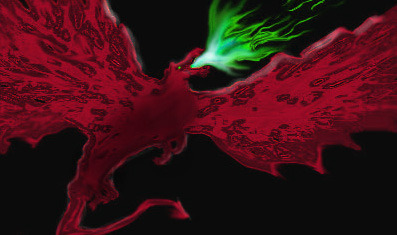 1. Dragons guard hoards of treasure not out of greed, but because of the healing properties of gold and other precious metals. Dragons lying on hoards have been overheard purring contentedly.
1. Dragons guard hoards of treasure not out of greed, but because of the healing properties of gold and other precious metals. Dragons lying on hoards have been overheard purring contentedly.2. That's right, some dragons purr, like cats. This should not, however, be taken as a sign that the dragon is well-disposed toward you. Deep contented purring often precedes a particularly vicious attack.
3. The average dragon's pulse is one beat per minute. A dragon's heartbeat may be audible from a mile away, or felt as a tremor in the ground from an even greater distance. That is why many professional dragonslayers go barefoot, to get as much advance warning of the presence and location of their enemy as possible.
4. Dragon bone is the hardest substance known to be produced by animal bodies. On the Mohs scale of hardness (in which diamond rates at 10), human tooth enamel is rated at 5, and dragon bone comes in at 9, the same hardness as sapphires and rubies, and far harder than quartz, iron and steel.
5. The longest-lived dragon is reputed to be Tau Lung, who was born before the formation of the Earth and inhabits the Sun (he may be responsible for sunspots and solar flares). The shortest-lived dragons are the "offspring" of Motherworms, immense sack-like black dragons capable of vomiting hundreds of small fiery "drakelets" at their enemies. The drakelets can briefly fly on their own power but in a matter of moments they fall apart into gobbets of flame or burn to ash. Since the drakelets do not last long enough to reach maturity, it is not known how Motherworms actually reproduce.
6. There are seventeen officially recognized classes of dragon, including the well-known Firedrakes, as well as ice dragons, riverdrakes, celestial dragons, bookwyrms, etc. The classification of certain dragon-like creatures is currently in dispute, most notably in the case of the scaly flatwyrm, a parasitic organism that infests the digestive system of dragons and can grow to be over one hundred feet long. The scaly flatwyrm most often infests fire-breathers, and its irritating presence in the dragon's bowels is said to be the real reason these dragons so often hate and attack humans.
7. Dragonflesh contains no fat. It is the healthiest and most vitamin-rich meat available, if you can get it. One has to be careful cooking dragonmeat, however, since it can spontaneously combust in an explosive burst of liquid fire.
8. The most intelligent dragon ever known, Auggg the Venerable, held a professorship in astronomy at Hypatian University in New Alexandria. She taught there for seventy-nine years before taking a well-earned retirement, though she still continued to give very popular lectures as a Professor Emeritus. Her office was a cavern deep underground said to be lined with the bones of hapless graduate students who never finished their dissertations.
9. The vulnerable spot on a dragon's hide is not always on its underbelly. Dragons have been known to have what professional dragonslayers call "sweet spots" on other parts of their bodies, including the head, limbs, and tail. There have been legendary dragons whose hides were said to be completely impenetrable, but these creatures apparently all died of boredom after several centuries and thousands of failed attempts on their lives.
10. According to most enigmatists, a dragon is an event, not a thing. A fire-breather, for example, is what happens when heat, oxygen, and combustible material combine with story.
Image by TW

Published on October 17, 2011 10:41



